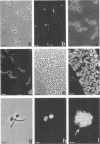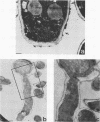Abstract
Numerous reports purporting the existence of form-specific antigens of Candida albicans have been published, but it is generally unclear whether antigenic variability is an acceptable alternative interpretation. In this study, we used indirect immunofluorescence and immunogold electron microscopy to determine the distribution and form specificities of two antigens during yeast and hyphal growth in several defined and complex media. The results confirmed that antigen expression varies with length of incubation, nutrition, and serotype and indicate that the form specificities of antigens may be misinterpreted when conclusions are based exclusively on indirect immunofluorescence and extraction procedures. We therefore suggest that investigations be designed to include serotype A and B isolates grown in both complex and chemically defined media and that agglutination, immunofluorescence, or enzyme-linked immunosorbent assays on whole cells or cell extracts be used as presumptive tests. Confirmation of form-specific antigens should be done by appropriate immunoelectron microscopic evaluation.
Full text
PDF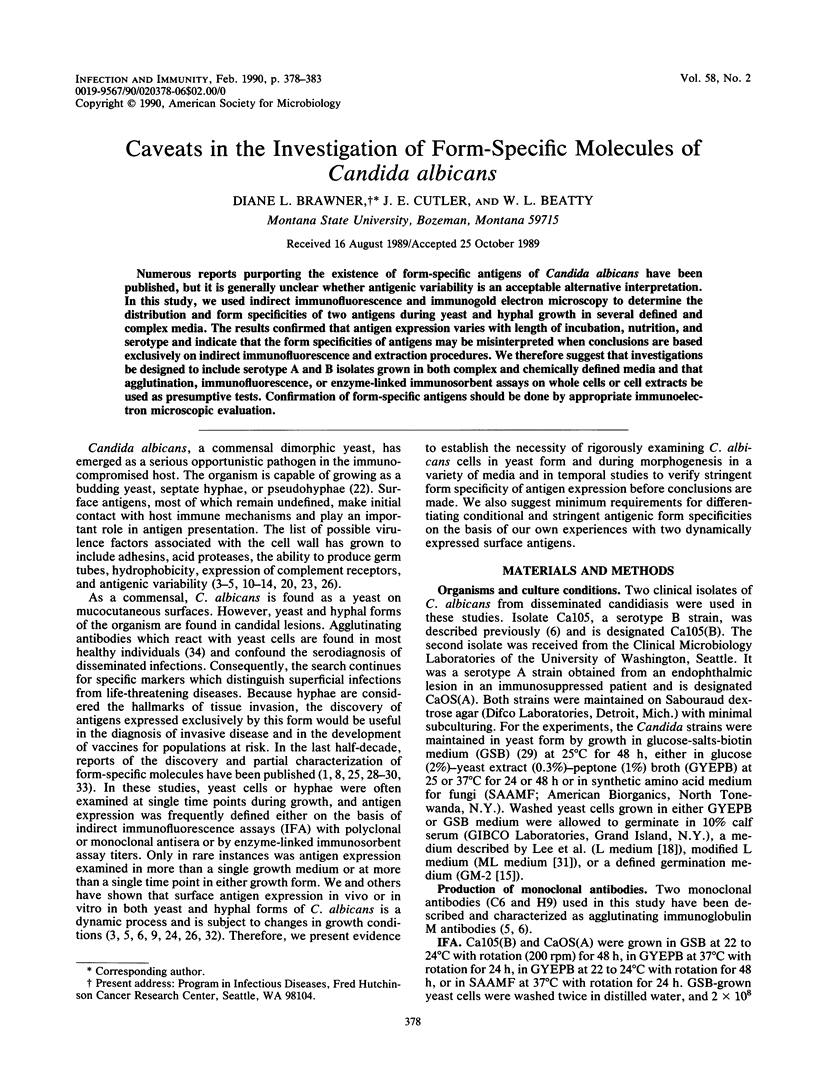
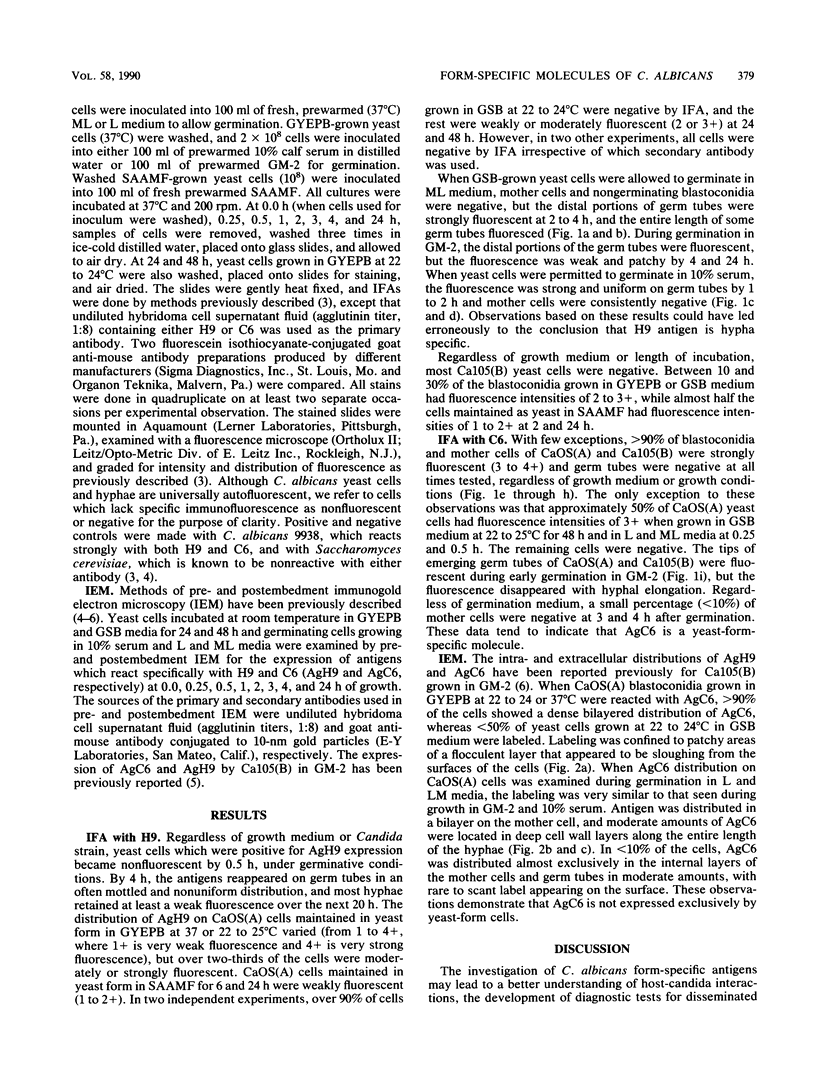
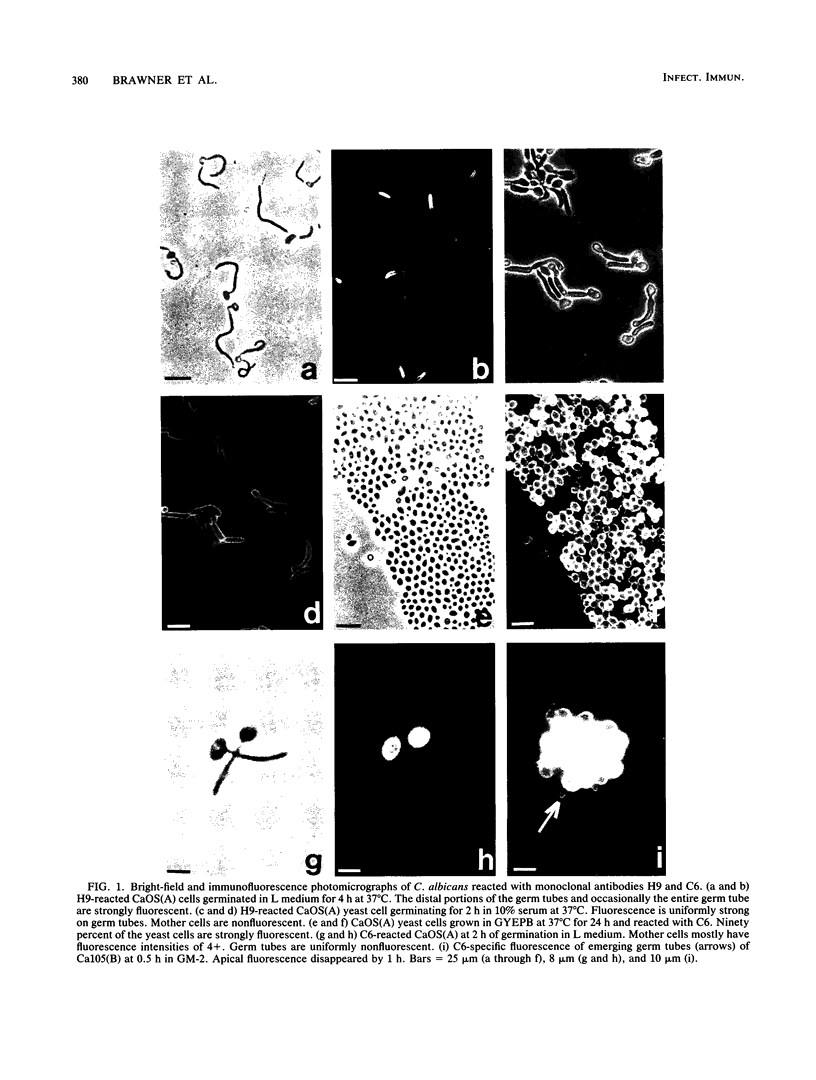
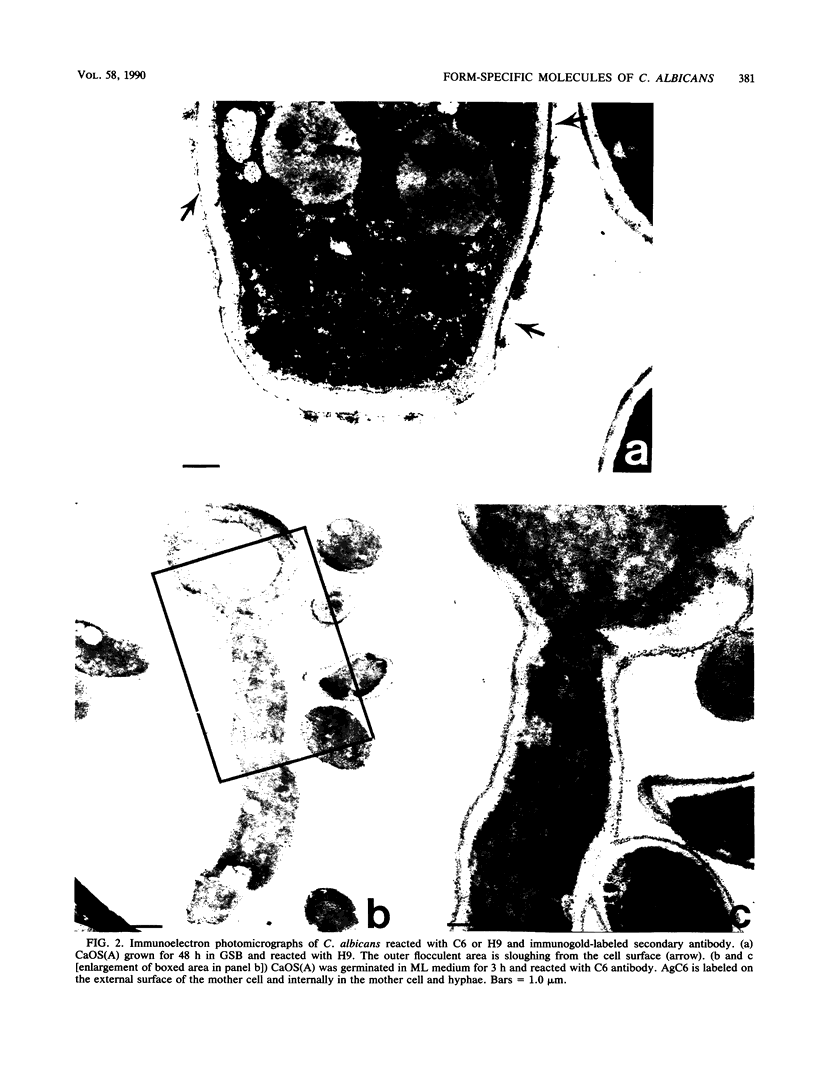
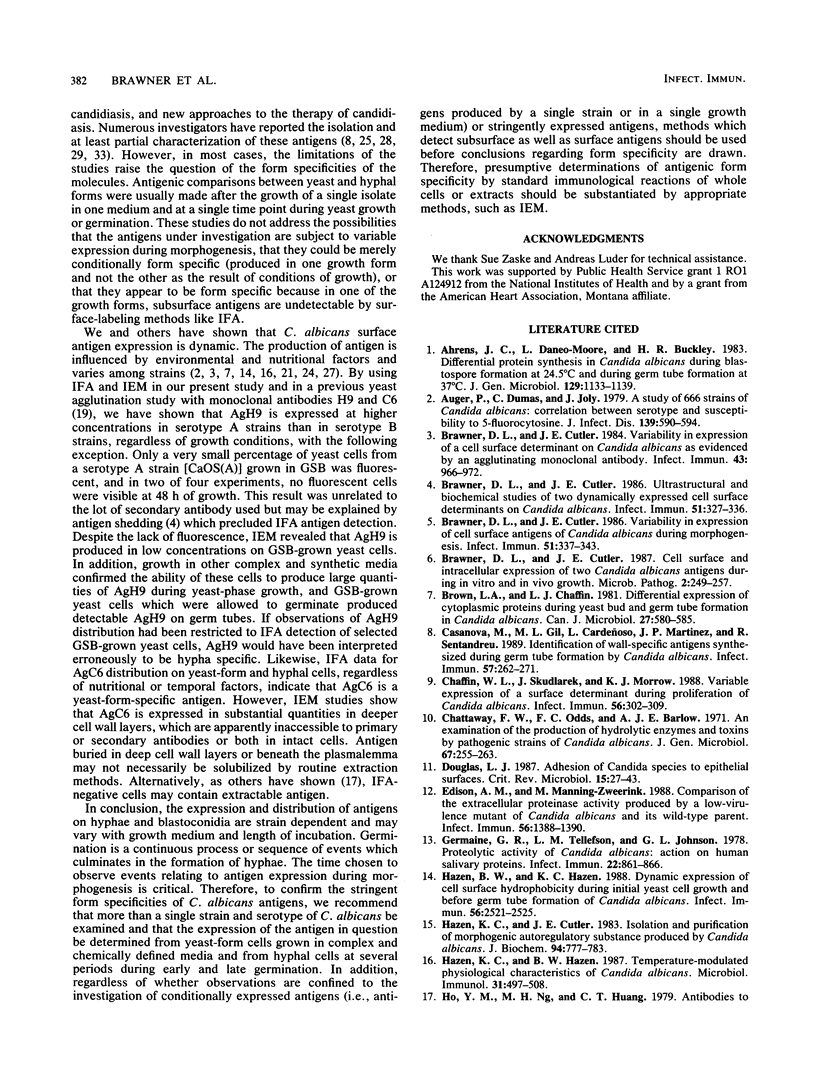
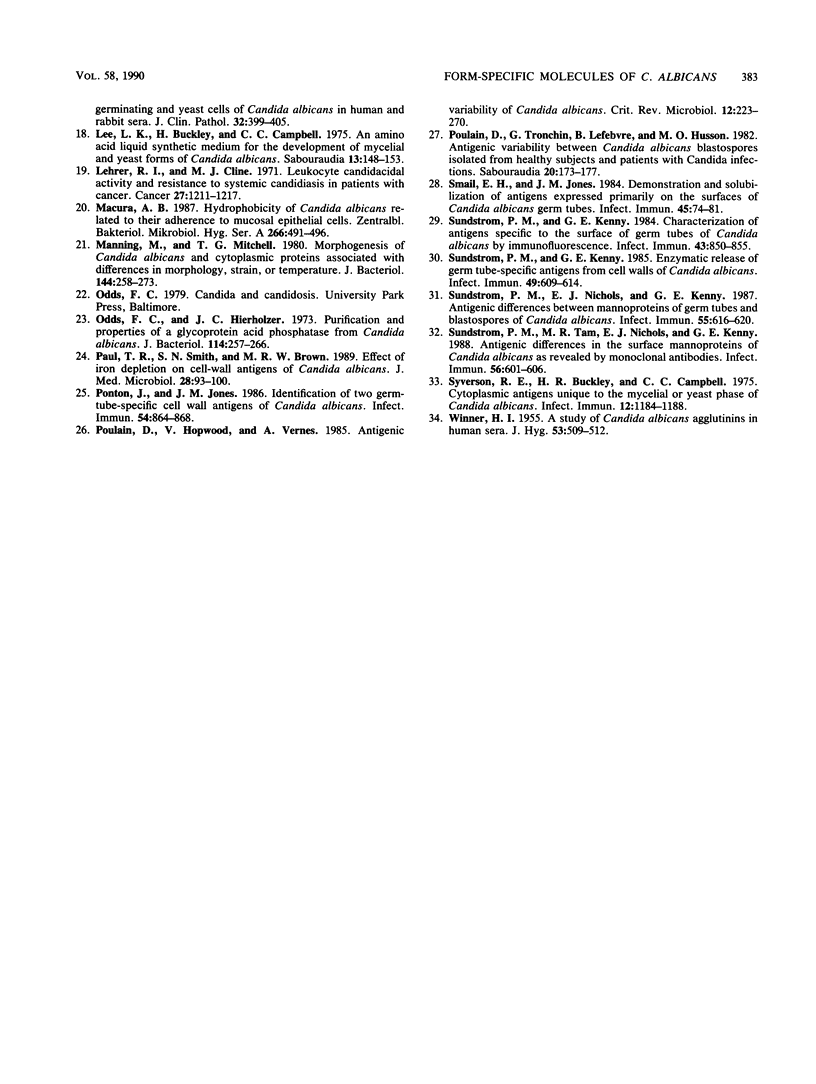
Images in this article
Selected References
These references are in PubMed. This may not be the complete list of references from this article.
- Ahrens J. C., Daneo-Moore L., Buckley H. R. Differential protein synthesis in Candida albicans during blastospore formation at 24.5 degrees C and during germ tube formation at 37 degrees C. J Gen Microbiol. 1983 Apr;129(4):1133–1139. doi: 10.1099/00221287-129-4-1133. [DOI] [PubMed] [Google Scholar]
- Auger P., Dumas C., Joly J. A study of 666 strains of Candida albicans: correlation between serotype and susceptibility to 5-fluorocytosine. J Infect Dis. 1979 May;139(5):590–594. doi: 10.1093/infdis/139.5.590. [DOI] [PubMed] [Google Scholar]
- Brawner D. L., Cutler J. E. Cell surface and intracellular expression of two Candida albicans antigens during in vitro and in vivo growth. Microb Pathog. 1987 Apr;2(4):249–257. doi: 10.1016/0882-4010(87)90123-9. [DOI] [PubMed] [Google Scholar]
- Brawner D. L., Cutler J. E. Ultrastructural and biochemical studies of two dynamically expressed cell surface determinants on Candida albicans. Infect Immun. 1986 Jan;51(1):327–336. doi: 10.1128/iai.51.1.327-336.1986. [DOI] [PMC free article] [PubMed] [Google Scholar]
- Brawner D. L., Cutler J. E. Variability in expression of a cell surface determinant on Candida albicans as evidenced by an agglutinating monoclonal antibody. Infect Immun. 1984 Mar;43(3):966–972. doi: 10.1128/iai.43.3.966-972.1984. [DOI] [PMC free article] [PubMed] [Google Scholar]
- Brawner D. L., Cutler J. E. Variability in expression of cell surface antigens of Candida albicans during morphogenesis. Infect Immun. 1986 Jan;51(1):337–343. doi: 10.1128/iai.51.1.337-343.1986. [DOI] [PMC free article] [PubMed] [Google Scholar]
- Brown L. A., Chaffin W. L. Differential expression of cytoplasmic proteins during yeast bud and germ tube formation in Candida albicans. Can J Microbiol. 1981 Jun;27(6):580–585. doi: 10.1139/m81-088. [DOI] [PubMed] [Google Scholar]
- Casanova M., Gil M. L., Cardeñoso L., Martinez J. P., Sentandreu R. Identification of wall-specific antigens synthesized during germ tube formation by Candida albicans. Infect Immun. 1989 Jan;57(1):262–271. doi: 10.1128/iai.57.1.262-271.1989. [DOI] [PMC free article] [PubMed] [Google Scholar]
- Chaffin W. L., Skudlarek J., Morrow K. J. Variable expression of a surface determinant during proliferation of Candida albicans. Infect Immun. 1988 Feb;56(2):302–309. doi: 10.1128/iai.56.2.302-309.1988. [DOI] [PMC free article] [PubMed] [Google Scholar]
- Chattaway F. W., Odds F. C., Barlow A. J. An examination of the production of hydrolytic enzymes and toxins by pathogenic strains of Candida albicans. J Gen Microbiol. 1971 Aug;67(3):255–263. doi: 10.1099/00221287-67-3-255. [DOI] [PubMed] [Google Scholar]
- Douglas L. J. Adhesion of Candida species to epithelial surfaces. Crit Rev Microbiol. 1987;15(1):27–43. doi: 10.3109/10408418709104446. [DOI] [PubMed] [Google Scholar]
- Edison A. M., Manning-Zweerink M. Comparison of the extracellular proteinase activity produced by a low-virulence mutant of Candida albicans and its wild-type parent. Infect Immun. 1988 May;56(5):1388–1390. doi: 10.1128/iai.56.5.1388-1390.1988. [DOI] [PMC free article] [PubMed] [Google Scholar]
- Germaine G. R., Tellefson L. M., Johnson G. L. Proteolytic activity of Candida albicans: action on human salivary proteins. Infect Immun. 1978 Dec;22(3):861–866. doi: 10.1128/iai.22.3.861-866.1978. [DOI] [PMC free article] [PubMed] [Google Scholar]
- Hazen B. W., Hazen K. C. Dynamic expression of cell surface hydrophobicity during initial yeast cell growth and before germ tube formation of Candida albicans. Infect Immun. 1988 Sep;56(9):2521–2525. doi: 10.1128/iai.56.9.2521-2525.1988. [DOI] [PMC free article] [PubMed] [Google Scholar]
- Hazen K. C., Cutler J. E. Isolation and purification of morphogenic autoregulatory substance produced by Candida albicans. J Biochem. 1983 Sep;94(3):777–783. doi: 10.1093/oxfordjournals.jbchem.a134419. [DOI] [PubMed] [Google Scholar]
- Hazen K. C., Hazen B. W. Temperature-modulated physiological characteristics of Candida albicans. Microbiol Immunol. 1987;31(6):497–508. doi: 10.1111/j.1348-0421.1987.tb03112.x. [DOI] [PubMed] [Google Scholar]
- Ho Y. M., Ng M. H., Huang C. T. Antibodies to germinating and yeast cells of Candida albicans in human and rabbit sera. J Clin Pathol. 1979 Apr;32(4):399–405. doi: 10.1136/jcp.32.4.399. [DOI] [PMC free article] [PubMed] [Google Scholar]
- Lee K. L., Buckley H. R., Campbell C. C. An amino acid liquid synthetic medium for the development of mycelial and yeast forms of Candida Albicans. Sabouraudia. 1975 Jul;13(2):148–153. doi: 10.1080/00362177585190271. [DOI] [PubMed] [Google Scholar]
- Lehrer R. I., Cline M. J. Leukocyte candidacidal activity and resistance to systemic candidiasis in patients with cancer. Cancer. 1971 May;27(5):1211–1217. doi: 10.1002/1097-0142(197105)27:5<1211::aid-cncr2820270528>3.0.co;2-3. [DOI] [PubMed] [Google Scholar]
- Macura A. B. Hydrophobicity of Candida albicans related to their adherence to mucosal epithelial cells. Zentralbl Bakteriol Mikrobiol Hyg A. 1987 Oct;266(3-4):491–496. doi: 10.1016/s0176-6724(87)80231-6. [DOI] [PubMed] [Google Scholar]
- Manning M., Mitchell T. G. Morphogenesis of Candida albicans and cytoplasmic proteins associated with differences in morphology, strain, or temperature. J Bacteriol. 1980 Oct;144(1):258–273. doi: 10.1128/jb.144.1.258-273.1980. [DOI] [PMC free article] [PubMed] [Google Scholar]
- Odds F. C., Hierholzer J. C. Purification and properties of a glycoprotein acid phosphatase from Candida albicans. J Bacteriol. 1973 Apr;114(1):257–266. doi: 10.1128/jb.114.1.257-266.1973. [DOI] [PMC free article] [PubMed] [Google Scholar]
- Paul T. R., Smith S. N., Brown M. R. Effect of iron depletion on cell-wall antigens of Candida albicans. J Med Microbiol. 1989 Feb;28(2):93–100. doi: 10.1099/00222615-28-2-93. [DOI] [PubMed] [Google Scholar]
- Ponton J., Jones J. M. Identification of two germ-tube-specific cell wall antigens of Candida albicans. Infect Immun. 1986 Dec;54(3):864–868. doi: 10.1128/iai.54.3.864-868.1986. [DOI] [PMC free article] [PubMed] [Google Scholar]
- Poulain D., Hopwood V., Vernes A. Antigenic variability of Candida albicans. Crit Rev Microbiol. 1985;12(3):223–270. doi: 10.3109/10408418509104430. [DOI] [PubMed] [Google Scholar]
- Poulain D., Tronchin G., Lefebvre B., Husson M. O. Antigenic variability between Candida albicans blastospores isolated from healthy subjects and patients with Candida infection. Sabouraudia. 1982 Sep;20(3):173–177. [PubMed] [Google Scholar]
- Smail E. H., Jones J. M. Demonstration and solubilization of antigens expressed primarily on the surfaces of Candida albicans germ tubes. Infect Immun. 1984 Jul;45(1):74–81. doi: 10.1128/iai.45.1.74-81.1984. [DOI] [PMC free article] [PubMed] [Google Scholar]
- Sundstrom P. M., Kenny G. E. Characterization of antigens specific to the surface of germ tubes of Candida albicans by immunofluorescence. Infect Immun. 1984 Mar;43(3):850–855. doi: 10.1128/iai.43.3.850-855.1984. [DOI] [PMC free article] [PubMed] [Google Scholar]
- Sundstrom P. M., Kenny G. E. Enzymatic release of germ tube-specific antigens from cell walls of Candida albicans. Infect Immun. 1985 Sep;49(3):609–614. doi: 10.1128/iai.49.3.609-614.1985. [DOI] [PMC free article] [PubMed] [Google Scholar]
- Sundstrom P. M., Nichols E. J., Kenny G. E. Antigenic differences between mannoproteins of germ tubes and blastospores of Candida albicans. Infect Immun. 1987 Mar;55(3):616–620. doi: 10.1128/iai.55.3.616-620.1987. [DOI] [PMC free article] [PubMed] [Google Scholar]
- Sundstrom P. M., Tam M. R., Nichols E. J., Kenny G. E. Antigenic differences in the surface mannoproteins of Candida albicans as revealed by monoclonal antibodies. Infect Immun. 1988 Mar;56(3):601–606. doi: 10.1128/iai.56.3.601-606.1988. [DOI] [PMC free article] [PubMed] [Google Scholar]
- Syverson R. E., Buckley H. R., Campbell C. C. Cytoplasmic antigens unique to the mycelial or yeast phase of Candida albicans. Infect Immun. 1975 Nov;12(5):1184–1188. doi: 10.1128/iai.12.5.1184-1188.1975. [DOI] [PMC free article] [PubMed] [Google Scholar]
- WINNER H. I. A study of Candida albicans agglutinins in human sera. J Hyg (Lond) 1955 Dec;53(4):509–512. doi: 10.1017/s0022172400001005. [DOI] [PMC free article] [PubMed] [Google Scholar]



